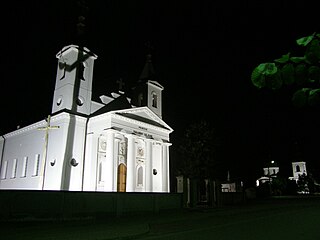
Zabłudów is a town in Białystok County, Podlaskie Voivodeship, in north-eastern Poland. Prior to 1999 it was part of the Białystok Voivodeship (1975–1998).
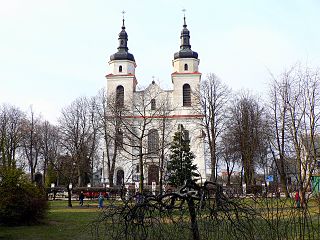
Jedwabne is a town in northeast Poland, in Łomża County of Podlaskie Voivodeship, with 1,942 inhabitants (2002). It is notable for the Jedwabne pogrom of 10 July 1941, during the World War II German occupation of Poland.

Szydłów is a fortified town in Staszów County, Świętokrzyskie Voivodeship, in southeastern Poland. It is the seat of the gmina called Gmina Szydłów. It lies approximately 13 kilometres (8 mi) west of Staszów and 43 km (27 mi) south-east of the regional capital Kielce.
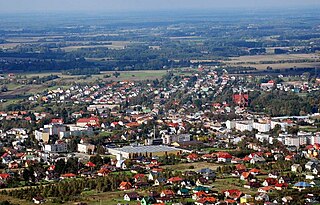
Nasielsk is a small town in Masovian Voivodeship, Poland. It is located approximately 50 kilometres (31 mi) north of the Polish capital Warsaw, on the Warsaw-Gdańsk rail line and serves as a railway junction. In 2020, the population of the town was estimated at 7,650 residents.
Pohrebyshche is a small city in Vinnytsia Oblast, Ukraine. It is the administrative center of Pohrebyshche Raion (district) in western Ukraine. Pohrebyshche is situated near the sources of the Ros River. Population: 9,209.

The Great Synagogue in Piotrków Trybunalski,, was built between 1791-1793 and designed by David Friedlander. The synagogue was devastated by Nazis during World War II. After the war, the building was renovated and it now serves as a library.
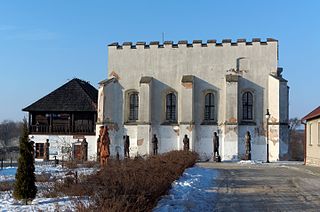
Szydłów Synagogue was an Orthodox Judaism synagogue in Szydłów, Poland. It was built in 1534–1564 as a fortress synagogue with heavy buttresses on all sides. The synagogue was devastated by Nazis during World War II. During the war it served as a weapons and food magazine. After the war, it briefly served as a village cinema, but was eventually abandoned.

Przedbórz is a town in Radomsko County, Łódź Voivodeship, Poland, with 3,458 inhabitants (2020). Przedbórz is situated on the Pilica River in the northwestern corner of the historic province of Lesser Poland. From its foundation until the Partitions of Poland, it belonged to Lesser Poland’s Sandomierz Voivodeship.

The Jedwabne Synagogue was a Jewish synagogue located in the small town of Jedwabne, Poland. Built in 1770, it was an example of vernacular architecture and one of many wooden synagogues unique to the former Polish–Lithuanian Commonwealth. The layered, pitched roof visible in surviving exterior photographs conceals a series of massive trusses from which the great dome is suspended. The roof, which features three well-defined stages, is considered one of the most architecturally complex and interesting of wooden synagogue roofs. The synagogue was enlarged in the nineteenth century by the addition of one story extensions on each side for the use of the women of the community.

The Włodawa Synagogue in Włodawa, Poland is an architectural complex consisting of two historic synagogues and a Jewish administrative building, now preserved as a museum. The complex includes the Włodawa Great Synagogue of 1764–74, the late 18th century Small Synagogue, and the 1928 community building. It is "one of the best-preserved" synagogues in Poland.

Wooden synagogues are an original style of vernacular synagogue architecture that emerged in the former Polish–Lithuanian Commonwealth. The style developed between the mid-16th and mid-17th centuries, a period of peace and prosperity for the Polish-Lithuanian Jewish community. While many were destroyed during the First and Second World Wars, there are some that survive today in Lithuania.

The Łańcut Synagogue is a Baroque synagogue in Łańcut, Poland. The Łańcut Synagogue is a rare surviving example of the vaulted synagogues with a bimah-tower, that were built throughout the Polish lands in masonry from the sixteenth through the early nineteenth centuries.

The Przedbórz Synagogue was a wooden synagogue in Przedbórz, Poland.
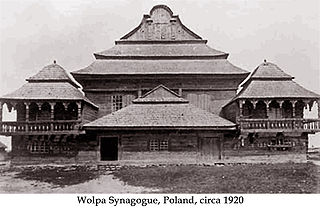
The Wołpa Synagogue was a synagogue located in the town of Voŭpa, in what is now western Belarus. It was reputed to be the "most beautiful" of the wooden synagogues of the former Polish–Lithuanian Commonwealth, a "masterwork" of wooden vernacular architecture.

The Gwoździec Synagogue was a synagogue located in the former Polish–Lithuanian Commonwealth in what is now Hvizdets in Ukraine. Built in the mid-17th century, the synagogue endured severe damage during the First World War, and was destroyed by the Nazis in 1941. The synagogue is notable for its highly elaborate ceiling decorations, which were reconstructed at the POLIN Museum of the History of Polish Jews.
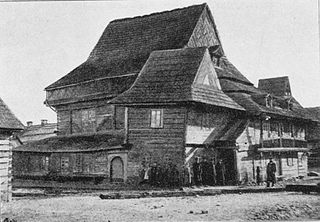
Zabłudów Synagogue - a former wooden synagogue building, located in Zabłudów, Poland, was erected in the 2nd quarter of the 17th century. It was burned to the ground by the German occupying authorities in June 1941 immediately after their conquest of the town.

Pohrebyshche Synagogue - a former wooden synagogue building, located in Pohrebyshche, a town in Vinnytsia Oblast, Ukraine, was built in the 17th century. It was destroyed in the 20th century.

The Great Synagogue of Brody, also known as the Old Fortress Synagogue, was the main synagogue of the Jewish community in Brody. Constructed in the mid-18th century, the building was significantly damaged by the Nazis in 1943, and has since fallen into disrepair.


















